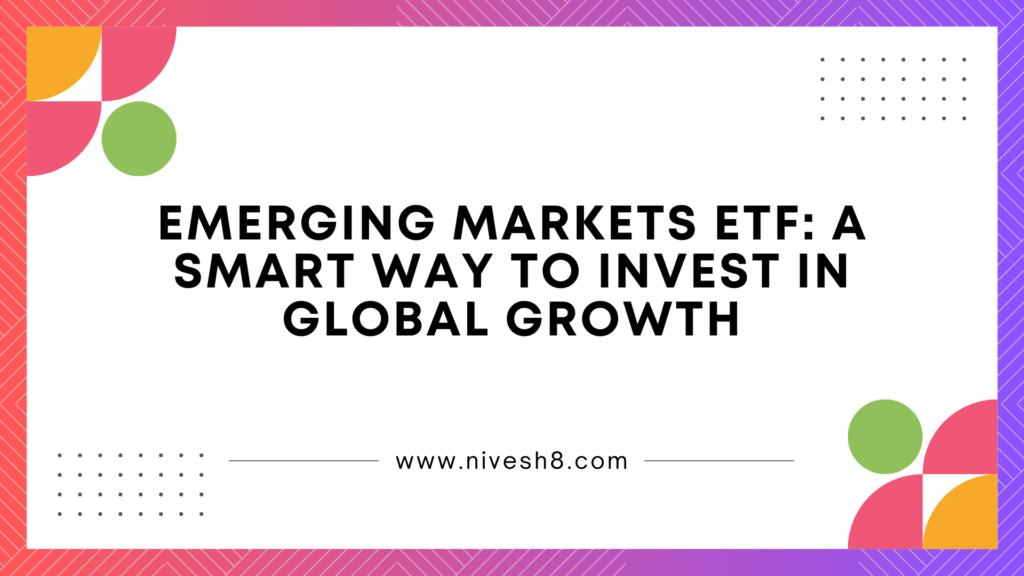Investing in ETFs from underdeveloped areas is one great way to diversify your portfolio and grab the opportunities presented by fast-growing economies. These investments expose one to countries including China, India, Brazil, and others with great economic development. This page will describe what emerging markets ETFs are, how they work, and which ones you should give some thought to for your investing plan.
An Emerging Markets ETF
Tracking a portfolio of stocks from developing nations, an ETF (Exchange-Traded Fund) is a type of fund. These countries define fast industrialization, great GDP growth, and expanding client bases. Unlike individual stocks, an ETF reduces risk by allowing you access to growth possibilities via a diversified group of assets.
Why Should One Invest in an Emerging Market ETF?
The following clarifies some of the attraction of ETF investments from emerging markets:
- Development potential of emerging countries usually exceeds that of industrialized ones.
- Including emerging countries in your portfolio encourages you to depend less on American or European stocks.
- Several developing market ETFs feature several dividend-paying companies.
- Learn about sectors and economies not found in industrialized markets.
- Generally speaking, ETFs are less costly than actively managed funds, hence they make sense for budgets.
The Fund Mechanics of Emerging Markets ETFs
Trading in stock markets, an ETF from an emerging market is exactly like any other ETF. Usually, they monitor well-known developing market indices including:
- MSCI Index of Emerging Markets
- Emerging Markets Index FTSE
- S&P Emerging Grade BMI
Inside an ETF for Emerging Markets
Usually carrying securities from countries like:
- China: Industry, finance, and technology.
- India: IT, consumer products, medications.
- Brazil: Mining, industry, and energy; agriculture, too.
- South Africa: Financial services and mining.
- Mexico: Industrial and energy sector.
Top 5 ETFs Emerging Markets Worth Examining for 2025
Among the best developing markets ETFs now available are the following:
Emerging Markets ETF Vanguard FTSE (VWO)
- Expense Ratio: 0.08%
- Holdings: Over 5,000 Chinese, Indian, Brazilian, and more stocks.
- Why It’s Great: Affordable with lots of exposure to many developing nations.
iShares MSCI Emerging Markets ETF (EEM)
- Expense Ratio: 0.68%
- Holdings: Focuses on mid- and large-cap companies.
- Why It’s Great: Among the most liquid ETFs in the category, rather regularly utilized ones are.
ETF Emerging Markets Equity Schwab (SCHE)
- Expense Ratio: 0.11%
- Track: The FTSE Emerging Index.
- Why It’s Great: Low expenses and robust diversification.
iShares Core MSCI Emerging Markets ETF (IEMG)
- Expense Ratio: 0.11%
- Holdings: More than 2,500 companies from 20+ underdeveloped countries.
- Why It’s Great: Offers a more whole picture than EEM.
Emerging Markets ETF from SPDR Portfolio
- Expense Ratio: 0.11%
- Holdings: Broad spectrum of recently emerged nations in the developing markets.
- Why It’s Great: Low-cost option with great long-term development possibilities.
Benefits of Buying an ETF for Emerging Markets
- One trade instantly diversified your portfolio with hundreds or thousands of stocks.
- Low expense ratios make them a low-cost alternative to mutual funds.
- Readily bought and sold for liquid investments on main stock markets.
- There are certain ETFs with steady dividend income.
- Unlike single equities, spreading investments throughout many countries reduces risk.
ETF Investing in Emerging Markets: Dangers
Even if they offer enormous development potential, emerging markets ETFs have certain risks:
- Policies: Doubtful government policies can influence markets.
- Currency Risk: Variations in exchange rates could reduce returns.
- Volatility: Emerging markets are often more volatile than developed markets.
- Economic Factors: Declining GDP or rising inflation could compromise performance.
How to Choose the Best ETF Designed for Emerging Markets?
Think over the following factors before selecting an ETF from developing markets:
- Expense Ratios: Lower costs over time translate into higher returns.
- Diversification: Choose investments with exposure to many countries and sectors.
- Liquidity: High trade volume implies easier purchasing and selling.
- Past Performance: Review past performance, but keep in mind that it does not guarantee future success.
- Dividends: Many ETFs offer dividends, increasing your whole return.
Emerging Market ETF Investing: Approaches
- Open a Brokerage Account: Start on a platform that allows ETF trading.
- Select an ETF: Choose the fund that aligns with your investment goals.
- Place an Order: Purchase ETFs for emerging markets exactly like you would stocks.
- Monitor Your Investment: Track market conditions and performance.
Often Asked Questions About ETFs for Emerging Markets
Should one invest long-term in ETFs from developing markets?
Indeed, they are ideal for long-term development considering the fast expansion of rising economies.
Are ETFs in developing markets paying off?
Several emerging markets ETFs do pay dividends depending on their underlying assets.
To what extent should I invest in developing countries?
This will be determined by your risk tolerance; financial advisers sometimes counsel between 10% and 20% of your portfolio.
Do developing markets ETFs have tax ramifications?
Indeed, capital gains from these ETFs and dividends could be taxable; consult a tax professional.
Conclusion
Especially as developing economies continue to expand, investing in an ETF from an emerging country can present quite interesting prospects. Choosing the right ETF will enable you to benefit from diversification, cost efficiency, and worldwide exposure. While there are hazards, savvy investing and careful choice of developing market ETFs will help you grab the opportunities presented by fast-growing economies.
Appreciate your investment.



